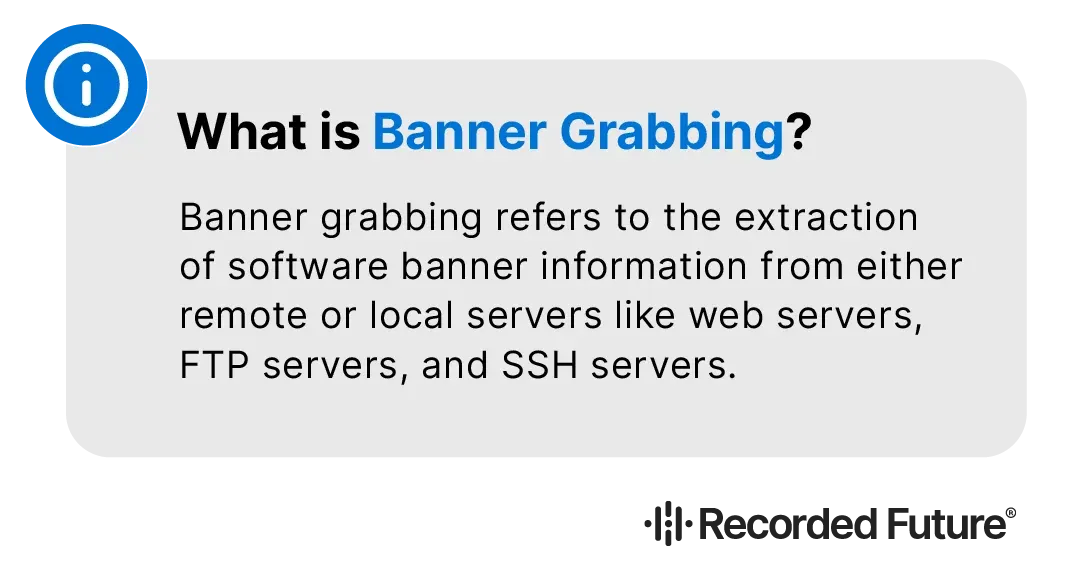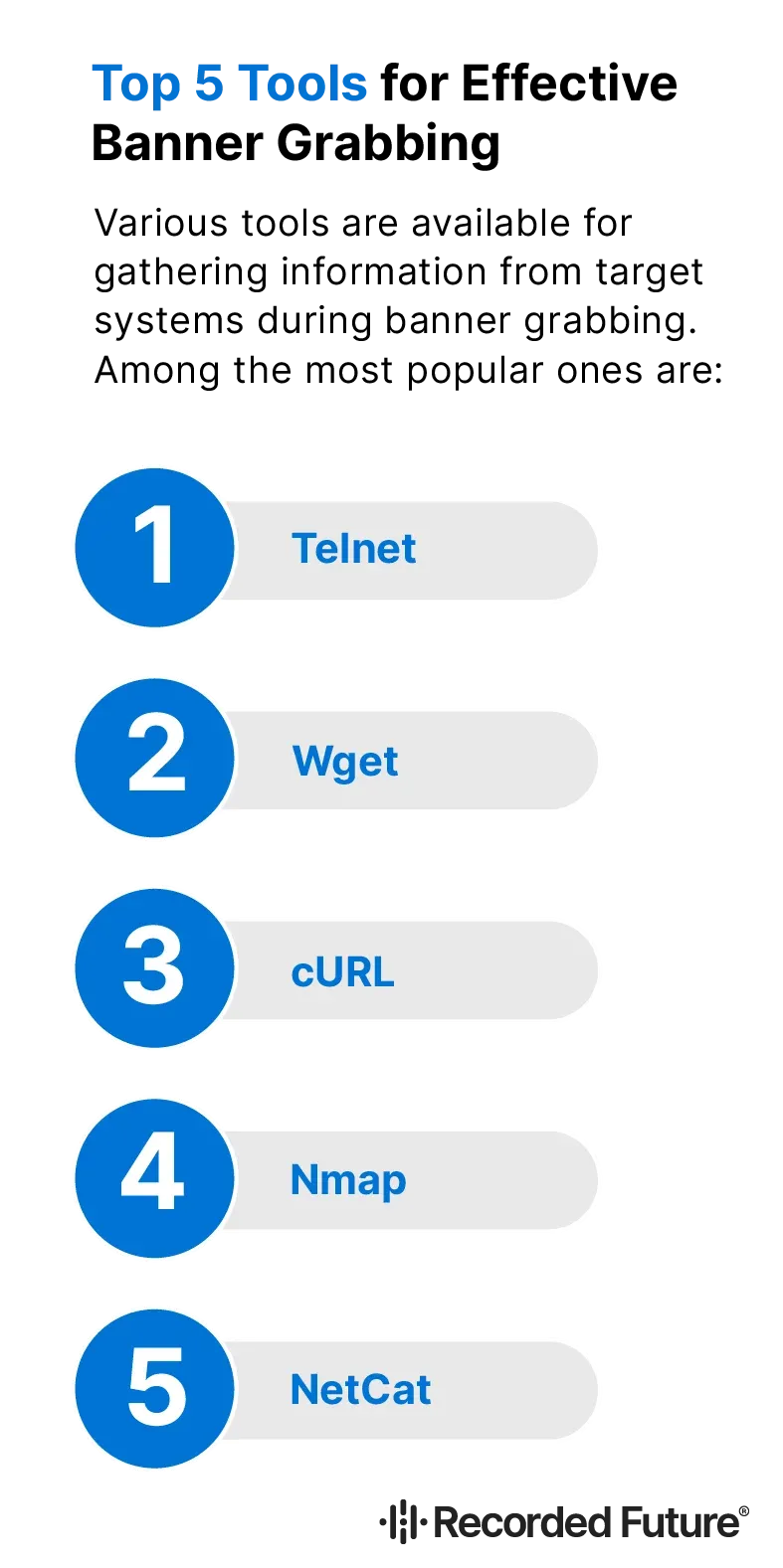Banner Grabbing: Tools and Techniques Explained
Understanding banner grabbing is essential for cyber defenders and potential attackers alike. The following article uncovers the critical techniques and tools for extracting system information and how to bolster your defenses against this probing method. Get to grips with banner grabbing and secure your network against exploitation.
Key Takeaways
- Banner grabbing is a technique used to collect software, service, and version information from network hosts, which can be used for both cybersecurity and malicious purposes.
- There are two main methods of performing banner grabbing: active, which involves directly connecting to a server, and passive, which collects information without direct interaction to avoid detection.
- To reduce the risk of banner grabbing, organizations should employ prevention strategies such as updating software, obscuring sensitive information, disabling unnecessary services, implementing firewall rules, and using intrusion detection systems.
What is Banner Grabbing?

**Banner grabbing refers to the extraction of software banner information from either remote or local servers like web servers, FTP servers, and SSH servers. **Insights about the operating system, services, and network hosts, including their versions on open ports, can be derived from the details gleaned from these banners. This information can be a goldmine for both defenders and attackers in the cybersecurity landscape.
Banner grabbing assists defenders in reducing and managing the attack surface exposure, and securing systems, whereas attackers leverage it to pinpoint insecure and vulnerable applications. The banner grabbing technique can be implemented via active or passive methods. Active methods involve sending packets to a remote server and analyzing the response, whereas passive methods rely on third-party tools to capture and analyze packets without direct interaction with the server.
Active vs. Passive Banner Grabbing
Banner grabbing techniques can be broadly categorized into two basic types of banner grabbing: active and passive. As the name implies, active banner grabbing establishes a connection, sends packets to a remote server, and then dissects the server’s response, thus taking an active approach. On the downside, this direct approach can potentially alert intrusion detection systems.
Conversely, passive banner grabbing takes a more stealthy approach. Rather than establishing a direct connection with the target server, it relies on strategically placed sensors in the network or third-party network tools. This method provides the advantage of gathering information without raising alarms on the target system.
Active Banner Grabbing
**The core of active banner grabbing revolves around the procedure of transmitting crafted packets to a target’s remote host and subsequently analyzing the responses. **This interaction can reveal critical information about the versions of running services and operating systems. The risk of being targeted by threat actors can be amplified when insecure and vulnerable applications inadvertently draw attention to themselves.
Certain tools, such as Wget and Dmitry, play a significant role in active banner grabbing. Wget can connect to and download files from a server, aiding in the collection of banner information. Meanwhile, Dmitry serves as a tool for port scanning and banner retrieval, collecting data on open ports along with software names and versions on the target network.
Passive Banner Grabbing
Contrasting active banner grabbing, which can be likened to a loud and assertive extrovert, passive banner grabbing could be considered its more reserved, introverted counterpart. Passive banner grabbing does not require direct interaction with the target system, using intermediated means to acquire service information. It gathers information via third-party network tools and services such as search engines or sniffing traffic while avoiding a direct connection.
Passive banner grabbing aims to collect the same information as active banner grabbing, but it employs an indirect data collection approach to minimize the risk of detection. Passive banner grabbing is a stealthy yet efficient way of obtaining vital information without drawing attention to the surveillance efforts.

Commonly Targeted Ports and Services
Certain network ports are prime targets in banner grabbing because of the popular services they operate and the sensitive information they can divulge. These include target web server ports such as:
- Port 80 (HTTP)
- Port 21 (FTP)
- Port 25 (SMTP)
- Port 22 (SSH)
- Port 443 (HTTPS)
- Port 3306 (MySQL)
Attackers often target these ports to gather specific data, such as server versions, service configurations, and SSL certificate details, which can reveal potential vulnerabilities. Thus, understanding which ports are most commonly targeted in these attacks is crucial for organizations to strengthen their security measures and protect sensitive information.
Top 5 Tools for Effective Banner Grabbing

Various tools are available for gathering information from target systems during banner grabbing. Among the most popular ones are:
- Telnet
- Wget
- cURL
- Nmap
- NetCat
These tools offer both command-line-based and web-based interfaces, making them flexible and convenient for different use cases.
Tools like Nmap, Netcat, and cURL are used in real-world applications by both security professionals and malicious actors to gather valuable system information.
Telnet
Telnet is a cross-platform client used to interact with remote services for banner grabbing. By entering the ‘telnet’ command followed by the target’s IP address or hostname and a specific port, you can perform banner grabbing using Telnet.
For example, for services running on web servers, the ‘telnet [hostname] 80’ command can be used, followed by an HTTP HEAD request, to extract meta information.
Banner grabbing via Telnet can reveal the exact version of the service running on a server by opening a connection to a determined IP address and port. Port 23, associated with Telnet services, is frequently targeted in banner grabbing for revealing detailed service information.
Nmap
Nmap is another powerful tool used in banner grabbing. The tool scans the system for open ports and retrieves information about operating systems and software versions. It is able to provide detailed insights into the system’s configuration and potential vulnerabilities.
The basic command for banner grabbing with Nmap is nmap -sV <target IP address or hostname>. For a more aggressive and detailed banner grabbing, Nmap can be instructed with nmap -sV –version-intensity 5 <target IP address or hostname> command.
Nmap also allows for a less intrusive and quicker banner grabbing using the command nmap -sV –version-intensity 0 <target IP address or hostname>. By using the –version-intensity flag, adjustable between 0 and 9, it allows for customization of banner grabbing attempts to control the depth of service analysis.
Netcat
Netcat, also known as ‘nc’, is a tool used on Unix/Linux systems to perform banner grabbing by analyzing server responses.
The Netcat command for banner grabbing often includes the options -vv for verbose outputs, -n to avoid DNS resolution, and -w1 for a one-second timeout. An example Netcat command for banner grabbing is echo “” | nc -vv -n -w1 <target IP address> <target port>.
Although Netcat comes preinstalled on Linux systems, it can also be downloaded and utilized on Windows via the command line, making it accessible for various users regardless of their operating system.
cURL
cURL, which stands for client URL, is a tool used to transfer data between servers, and it’s widely used for banner grabbing to retrieve banner data from HTTP servers.
To perform banner grabbing, the cURL command curl –s –I <target IP address> is used, where -s suppresses error messages and -I retrieves header information.
The HTTP headers fetched by cURL can include server type, cookies, and other valuable information that can act as banners during the grabbing process.
Additionally, cURL’s versatility allows it to be scripted for automating banner grabbing tasks and can be integrated with other security tools for comprehensive testing.
Wappalyzer
Wappalyzer takes a different approach to banner grabbing. It’s used in web applications banner grabbing to retrieve details of web application technologies and display the technologies, services, and versions. Wappalyzer can be installed as an extension on both Firefox and Google Chrome browsers, making it accessible for many users.
In addition to web technologies, Wappalyzer also identifies:
- CMS platforms
- JavaScript frameworks
- Analytics tools
- And many other services used by a website
What sets Wappalyzer apart is its user-friendly interface. It presents gathered information in an organized manner, aiding quick assessment of a website’s tech stack without needing to manually inspect page source or headers.
Prevention Strategies to Protect Against Banner Grabbing
Let’s now deep dive into practical strategies to protect against banner grabbing attacks.
Enhancing System Security
Although banner grabbing can serve as a potent tool for cybercriminals, robust prevention strategies, often developed through the collaborative efforts of red teams and blue teams, exist that can guard against banner grabbing attacks.
One of the most fundamental steps is to keep software, including antivirus programs and operating systems, patched to protect against vulnerabilities exploited by banner grabbing tools. Changing the default server banners to remove sensitive information, a practice known as security through obscurity, such as software and version numbers, can also help to hide potential attack vectors.
Moreover, disabling any unnecessary services on the server, implementing strict firewall rules limiting public access, and considering network proxies can reduce the risk of banner information being grabbed. Additionally, using intrusion detection and prevention systems to monitor for banner grabbing attempts can potentially deter attackers by displaying customized warning banners.
Proactive Defense through Ethical Hacking
In the context of banner grabbing, it's crucial to understand how attackers leverage this technique to uncover known and exploitable vulnerabilities within a system. By targeting open TCP ports, they can send requests to a local server, aiming to retrieve response data that unveils remote banners. These banners often contain critical information about the web applications running, including the types of different intermediate software in use.
Ethical hacking is pivotal in defending against these attacks. Security teams, by engaging in ethical hacking, use their skills to identify open TCP ports and patch these vulnerabilities, ensuring the computer system is safeguarded against the Eternal Blue attack and other similar threats. For instance, employing tools like the Deepmagic Information Gathering Tool allows them to automate the search of websites and efficiently collect data through the Hyper Text Transfer Protocol (HTTP). This discovery process is critical for them to identify unnecessary services running on the server, which might be shut down to enhance security.
Securing Digital Assets Against Cyber Threats
By simulating attacks, such as banner grabbing tools and strategies, ethical hackers can assess how attackers might use web crawlers to automate the gathering of information from all the requested pages. This proactive approach aids in identifying vulnerabilities and implementing measures to obscure or modify service banners, thereby reducing the chances of attackers successfully leveraging banner grabbing attacks to infiltrate the system.
Moreover, ensuring that the computer system does not display banners that could provide attackers with valuable insights is vital. By not revealing too much server information and keeping the hypertext transfer protocol (HTTP) secure, organizations can mitigate the risks associated with these attacks. Ultimately, safeguarding against banner grabbing involves a comprehensive strategy that includes patching known and exploitable vulnerabilities, hiding service banners, and ensuring that any disclosed information does not aid potential attackers in gaining unauthorized access.
Frequently Asked Questions
Is banner grabbing illegal?
Banner grabbing is not illegal and is commonly used in ethical hacking to test networks and security.
What is banner grabbing using telnet?
Banner grabbing using telnet is a reconnaissance technique to gather information about the target system or application running on a network. It involves opening a Telnet connection to various TCP ports on the target system to record the banner information.
What is banner grabbing during enumeration?
Banner grabbing is a method used to obtain information about computer systems and services on open ports, providing details such as software type and version. It is used by attackers and security teams for enumeration purposes.
How is banner grabbing performed?
Banner grabbing can be performed using active or passive methods. Active methods involve sending packets to a server and analyzing the response, while passive methods use third-party tools to capture and analyze packets without direct interaction with the server.
Summary
Banner grabbing is a crucial concept in the world of cybersecurity, serving as a dual-edged sword that can be used for both offense and defense. On the one hand, it provides invaluable insights into system vulnerabilities, helping security professionals secure their networks. On the other hand, it can expose those same vulnerabilities to attackers, highlighting the need for robust prevention strategies.
In an increasingly digital world, understanding banner grabbing and how to protect against it is more important than ever. Keeping software updated, changing default server banners, disabling unnecessary services, implementing strict firewall rules, and using intrusion detection and prevention systems are all critical steps in safeguarding against banner grabbing. As we continue to navigate the digital landscape, staying vigilant and informed is our best defense.
Beyond manual banner grabbing
Recorded Future’s Attack Surface Intelligence offers a sophisticated platform designed to manage your external attack surface comprehensively. It includes conducting reconnaissance on all your digital assets, enabling you to detect software versions, open ports, exposed databases, and more across your company’s sites on a large scale. This capability allows for not only the identification of software versions but also facilitates pivoting between critical risks detected on the affected assets.
Elevate your security strategy beyond manual banner grabbing. Book a demo now and discover a new horizon in comprehensive external attack surface management.

Esteban is a seasoned security researcher and IT professional with over 20 years of experience, specializing in hardening systems and networks, leading blue team operations, and conducting thorough attack surface analysis to bolster cybersecurity defenses. He's also a skilled marketing expert, specializing in content strategy, technical SEO, and conversion rate optimization. His career includes roles as Security Researcher and Head of Marketing at SecurityTrails, before joining the team at Recorded Future.
Related News & Research



